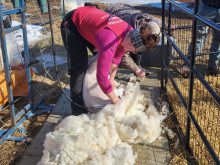RED DEER – Alberta egg producers are encouraging their members to provide more cage space for laying hens.
Producers at the Alberta Egg Producers annual meeting were warned the perception of birds living in crowded cages could drive away major egg buyers like grocery stores and fast food chains.
“If you people don’t get your act together and get the proper cage size and enshrine it in your regulations, within five years we are going to have the grocery chains coming into our barns if we cannot prove to them we give those birds so many square inches,” said Manfred Kannehl of Stony Plain, who chairs the group’s animal welfare committee.
Read Also

Charges laid after cattle theft
Saskatchewan RCMP lay two charges against a man after six cattle went missing.
After intense debate, producers agreed to a resolution requiring more space.
It said producers with cage density below 64 sq. inches per bird are not entitled to additional chickens and egg quota. Producers who have a larger cage density than that and who acquire new quota must put the new layers in new cages with a minimum of 67 sq. inches per head. In addition, newly built or renovated production facilities must provide for a minimum cage density of 67 sq. inches.
The new recommended size was introduced in the egg producers’ 2003 code of practice.
It recommends adult birds weighing 1.7 kilograms should have 67 sq. inches of space. These are typically white egg layers. Birds weighing 1.9 kg need 75 sq. inches of space. These are typically brown egg layers.
Alberta and Quebec are the only provinces to regulate chicken density. Alberta stated in 1995 that cages must be a minimum of 64 sq. inches according to the code of practice at the time, said Steve Howe, president of the Alberta Egg Producers.
“The problem is producers who built barns in the last three years. They invested a quarter million dollars or more and they built in extra space according to 64 inches because that’s what the code said at the time,” he said.
Fast food giant McDonald’s Corp. has told its Canadian suppliers birds must have 72 sq. inches per bird.
Howe said the egg producers are going to recommend producers provide more space than the code of practice recommends.
“We believe McDonald’s is always going to ask for more than what you have. If we go to 72, then they’re going to say ‘now we want 76 or 80,’ ” he said in an interview.
Research paid for by the egg producers and the Alberta Farm Animal Care association is looking at enhanced cages that provide more space, nesting areas and perches.

















